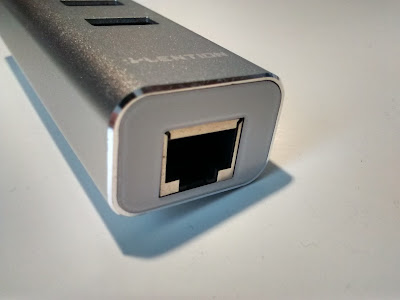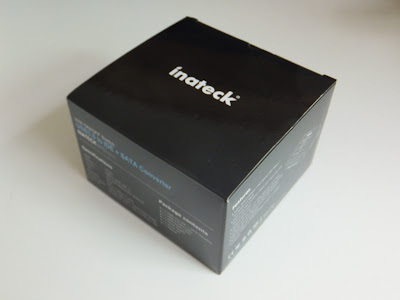I recently bought a
Nitecore MT06 at my local retailer (i went in to get a
Nitecore Tube, but bought both the Tube, and the MT06.
The Nitecore MT06 is a great pen sized flashlight featuring a 165lm max light output.. but for how long before the thermal throttling feature starts?
The specs
the official ones
Benchmarking
The tools
To get an idea of the flashlight performance i needed a way to measure the Luminous intensity (cd). Having no professional tool for that i used the
CT406 light sensor that is embedded in the Moto G first gen (XT1032) : the results won't be complying with the ANSI/NEMA FL1 standard but will be good enough to get our own idea of the flashlight performance.
Tools and Methods:
- Power source: 2*AAA Energizer Rechargeable NH12 (Brand New)
- Light sensor: CT406, giving results in illuminance in Lux(lx) turned into Luminous intensity via this formula:
Iv(cd) = Ev(lx) × (d(m))^2
- Calculated light output in Lumens (lm) :
lm = cd × ( 2π(1 - cos(apex angle in °/2)) )
- Calculated throw (beam distance in meters) :
throw (lm) = sqrt(candela/0.25)
How to get the experimental light outpout?
As written above, the formula is the following :
lm = cd × ( 2π(1 - cos(apex angle in °/2)) )
The measured apex angle is roughly 18° (result that we also can get using the advertised light output and the peak beam intensity [165lm, 2120cd ==> 18°])
EDIT: How to get the Surface temperature?
A simple crappy medical contact less thermometer (the Powerscan TH23F -that i recently got for 3€, and does not worth much more-) allows to measure the surface temperature of the flashlight body (with a maximum inaccuracy of about 1°C) , this does not give the real chip temp, but gives some interesting clues.
The experiment was carried out during 40 minutes. In three phases :
- MT06 set to high, as long as it can (meaning until it was too hot to even touch and hold... the ON/OFF switch!
- After a two minutes cool down (from really hot to warm), another period on high mode. untill it reaches the same heat trigger : human pain...
- Sixteen minutes in low mode to see how consistent the light output is when regulated.
EDIT: A second experiment is now added : full run from max to 1lm, to show both thermal throttling and runtime
Results...
Measured vs Advertised specs (high mode):
The FL1 standard asks to wait for 30 to 120 seconds before measuring the peak beam intensity
The first result (max) is obtained right after turning ON the flashlight, the second (FL1) complies with the FL1 standard and is compared to the official specs.
| Advertised | Measured |
|---|
| Peak Beam Intensity (max) | | 2238 cd |
| Peak Beam Intensity (FL1) | 2120 cd | 2114-2135 cd |
| Light Output (max) | | 173 lm |
| Light Output (FL1) | 165 lm | 163-164 lm |
| Beam Distance (max) | | 94 m |
| Beam Distance (FL1) | 92 m | 92 m |
Considering the inaccuracy of the angle measure and the use of a
CT406 as light sensor, it seems that Nitecore claims are absolutely legit.
Measured vs Advertised specs (low mode):
| Advertised | Measured |
|---|
| Peak Beam Intensity (FL1) | | 422 cd |
| Light Output (FL1) | 32 lm | 32.5 lm |
| Beam Distance (FL1) | | 41 m |
... and Thermal Throttling
Here is what Nitecore says on the MT06 user manual :
"NOTE: The MT06 will begin adjusting output lumens automatically after 5 minutes of use, thus preventing overheating and extending battery life"
Let's see how much this is true and how long we can get the advertised 165lm!
Having nothing to measure the own flashlight temperature, an apparent temperature has been used instead (human felt temperature in a subjective range : room temp, warm, hot, and too hot)

- Phase One:
- for 5 minutes is at about 165lm (as advertised) but heat is increasing quickly until no one would like to hold the flashlight any more... (green circle)
- Then, Thermal throttling start and the driver limits the led to 145lm which is still acceptable, though temperature decrease, the flashlight is still to hot to be comfortable to hold for a long time! (red circle)
- Nitecore advertises 165lm, 45 minutes of life time with two 1.2V 750mAh batteries, this mean that roughly 1A of current is flooding through the flashlight. Considering that a LED turns about 20% of energy to light, it means that 80% is turned into heat... so here the flashlight needs to dissipate about 2W of pure heat with its small aluminum boddy.
- Short period of cool down (from minute 10 to 12)
- Phase Two: This time the flashlight starts throttling less than one minutes after lighting up (not cooled enough during the 2 minutes stop period)
- Longer period of cool down : about 4 minutes
- Phase Three : Low mode, not much to say about it... It works without thermal throttling -hey, the heat to dissipate is only about 0.25W!-
EDIT: I made another benchmark with Surface temperature measurements:
This time, i made a full run from full batteries -at max output (aka 165lm mode)- until getting as low as 1lm of output (after 41 minutes of runtime)
Here we can see 4 phases
- Phase 0, the flashlight is turned ON and gives maximum output until thermal throttling strikes (when reaching a surface temp of about 50°C)
- Phase 1, thermal throttling shows up, and reduces the max output to limit heat dissipation, light output is really stable, but temperature rises slowly until reaching about 58°C
- Phase 2, thermal throttling gets a little more aggressive, lowering output to stop heat from rising more than 58°C, temperature is maintained this way for about 2 more minutes
- Phase 3, End of game: Batteries are dying and simply cannot supply enough current to maintain the light output, so it decreases - and so does surface temperature-
Conclusion
Don't expect to get 165lm for more than 5 minutes when the flashlight is starting at room temperature (but before thermal throttling start your hand won't feel good with that little heater after 3 mins...)
Nevertheless, this little flashlight performs great at low mode (high enough for what it's made for)
and provides 165lm if needed, for short times (thanks to thermal throttling you won't get heat burn...).
Keep in mind that the MT06 is not meant to be a tactical kubotan but more to "
provide great assistance to engineers, mechanical and medical personnel" (quoting Nitecore). for the late group (medical personnel,
this flashlight lacks a firefly/moonloght mode (0.3lm - 3lm) that could be used to perform Pupillary light reflex without blinding the patient...)
Note that although i couldn't see PWM in low mode, i could hear a very little noise (near to ultrasound) that appears both in low mode, and during thermal throttling. Don't worry this sound can only be heard with the pen light close to the hear -i never noticed anything like this on my Fenix LD12.
















































